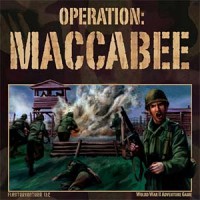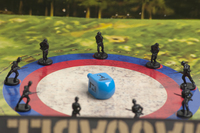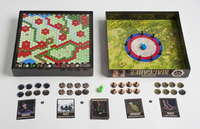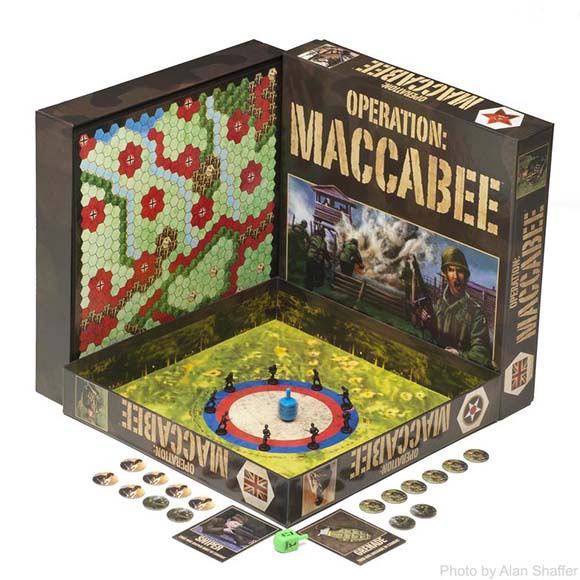
Operation: Maccabee
Be a Hero ... Spin the Dreidel ... Defeat the Nazis!
In 1944 as the Allies fought their way to Germany, the third Reich, issued their plan for the Final Solution to destroy all the Jews and other prisoners in their concentration camps. Allied intelligence agencies intercepted transmissions of this plan and launched a top secret covert operation to liberate these camps before the Nazis enacted their evil plan.

Now you must lead an elite squad of commandos from four of the allied countries: USA, UK, USSR & France. Avoid Nazi Patrols and find supplies like grenades and assistance from dead-eye resistance snipers as you sneak behind enemy lines to assault these concentration camps and liberate the prisoners from these terrible atrocities.
Game play overview:
Players can play as either the USA, UK, USSR or France. Each country has a unique starting position on the hex map board and starts with a specific set of starting powers. Players then spin the dreidel to determine movement points for the turn and can move anywhere on the hex map within range of their points. Different terrains require different numbers of points to move onto, need special equipment (acquired through action cards) to cross or contain potential Nazi ambushes where the players' commandos can get wounded. Players can also play certain action cards to increase movement for the turn as well as find more action cards depending on their spin.

Players transverse the board in order to land on the concentration camps. Once a player lands on one they may assault it and attempt to liberate it. The assault action takes place inside the box top assault area which has a 3 layered target in the center of a concentration camp. Nine Nazi guards are set up on the German crosses on the outer edge of the target. Then the player gets to spin the dreidel starting within the inner most circle of the target for each active commando they have.
The player gets to take one shot or dreidel spin per commando they have that is not wounded attempting to knock over the Nazi guards. The result of the spin can either kill more Nazis, allow a player to draw more action cards or one of their commandos might get wounded. Players may also play action cards like grenades or snipers to attempt to kill more guards during the assault by lobbing or tossing the dreidel into the assault area.
If they knock over all nine guards they liberate the camp and free the prisoners. On the back side of the camp tile there are two values. The first is the number of prisoners they freed and the second is the number of extra actions cards they may draw. Once all 11 camps are freed the player who has freed the most prisoners wins. Between battles players can move to Resistance Bases to heal commandos and get more equipment / action cards.

User Reviews (2)
Add a Review for "Operation: Maccabee"
You must be logged in to add a review.


What Is It About? – An Overview of the Game
In Operation: Maccabee, the goal of the game is to accumulate the most liberation points: each player represents one of the Allied nations rescuing prisoners from concentration camps. Movement and combat is resolved through spinning a dreidel as the randomizer. Movement is tracked by tokens on a board while combat is literally trying to knock out the Nazi guards. This can play up to 4 players in about an hour.
What Do I Get? – The Components in the Box
There is a mounted 12” x 12”game board to track movement and objectives. A quick terrain reference guide is printed on it. While the board is static (one scenario), the value of the camps change each game. The tokens are small pieces of cardboard, a bit too small for my tastes but fit the scale of the board. Each player gets a set of 8 commando tokens to track his health. A deck of cards showcases different objects/weapons to help you on your mission.
As far as plastic components, the game comes with two dreidels and nine plastic Nazi guards. The Nazis look exactly like the infantry figures from the Axis & Allies series of games. These guards will be set up in the box top which represents the battlefield. (Note – it is printed in the box top, I spent a long time looking for this as the back of the box makes it look like another game board!)
What Do I Do? – Playing the Game
Operation: Maccabee follows the “roll and move” category of games but substitutes a dreidel for dice. As such, you have a 25% chance of any one result. The dreidels have the Hebrew markings on them but they soon become easy to remember. Gimel is the best result you can get followed by Hei. Nun is typically neutral while Shin is usually harmful. I remember this by saying Hei is “half” of Gimel, while Nun usually nets you “none” and Shin sounds like “sin” so that must be bad (or a kick in the shin). In this game, though, they are slightly better than usual as mentioned below.
On your turn, you will spin the dreidel (alternatively, you may “roll” it as well to save time from watching it spin for a long time). If you get a Gimel, you have 4 movement points while Hei gives you 3 movement points. Nun grants you 1 movement point and a card draw. Shin results in an ambush by Nazis giving you no movement points.
You may then move up to the number of movement points aiming to get to the camps. Different terrain costs different points to enter, such as grassland at 1 and mountains at 3. In order to cross the rivers, you will need a Raft action card. The Boots action card also grants you +4 movement. Secret Map action cards allow you to “teleport” to any Concentration camp. If you land on a concentration camp, you then attempt to liberate it.
In order to liberate the camp, the player sets up 9 Nazi guards in the box top. You will get a number of spins based on the number of commando points still face up in your area (maximum of 8). The goal is with up to 8 spins, you must knock down 9 guards. When spinning, your dreidel must start in the center circle or the spin is forfeited and you “wound” a Command by turning it over (losing that spin until you can heal him again). In addition, to physically knocking them over, the result of the spin may also add more kills: 2 additional kills for Gimel, 1 for Hei and none for Nun and Shin (though Nun allows another card draw and Shin counts as a wound to that Commando). At this time, you may also spend Grenade and Sniper action cards for special attacks. Grenades allow you to “lob” with an underhand toss, the dreidel into the playing area while a Sniper is an overhand toss.
If you knock down all 9, then you get to take the camp token and see its value. If you fail to knock them all down, then you must move off of the camp and any attempt again will again start with 9 guards (exception, if another player is adjacent to the camp, they may attempt to take over where you left off and get full credit for knocking down the remaining guards).
Besides the terrain, there are two other important spaces to look out for. One is the red “Nazi patrol” zones. When you start your turn here, if you spin a Shin, you will have to wound one Commando in addition to not getting any movement points. So with a continuous spin of Shin, you may be trapped here for a long time losing many Commandos.
The other special space is the “resistance camp.” If you land here, on your next turn you skip movement. But you may spin to heal your Commandos: heal 2 for Gimel, 1 for Hei and none for Nun and Shin (though Nun allows another card draw). The First-Aid action card can also be spent at any time to heal one Commando.
While you are competing for liberation points, there is some direct player confrontation. A player can try to take over your hex (as only one unit can be on a space at a time) by having a spin off. The player whose dreidel spins the longest can force the other player to an adjacent hex. He may also steal one of his action cards if he can correctly guess one that he is holding.
After one player has had their movement and possible liberation attempt, play then passes counter-clockwise (as is the Hebrew way!) to the next player. The game is over once all 11 camps have been liberated. Players compare the values of the camps they have collected and the person with the most points wins.
What Do I Think? – Final Thoughts
This is an interesting game that blends a historical situation with a dexterity component. Using dreidels instead of dice for the random factor is fun and refreshing. While the movement and action on the main board is nothing special and a bit basic, the combat zone is the interesting part of the game. And while this is a matter of dexterity, learning not only to spin well but figuring out how to get the dreidel to actually move around gives you something to shoot for. You also need to figure out the best time to use your Grenades and Sniper cards. With a Grenade, sometimes it is just sufficient to let it shake the box to knock over Nazis instead of a direct hit. The Sniper is a bit more precise but better used when one Guard may have gotten pushed away from the main group.
While I would normally go for Memoir ‘44 when I want a WWII game with plastic figures, this is a fun diversion on occasion. The dreidel aspect makes this more interesting than just a standard filler. Using the dreidels for more than just spinning is an interesting twist from the other dreidel games by FlasterVenture LLC.
What Next? – Other Recommendations for this Game
As mentioned, FlasterVenture LLC has a series of games involving dreidels. Those are more spin and move and all follow the same basic premise of collecting something for the win. Maccabees is the first and most general of the bunch, good as entry to the series. Matzakoman has a little more layers and better suited for those more experienced gamers. Queen Ester’s Dancing Dreidels is a little more entry level but aimed specifically at girls. The similarity is just in the dreidel, however.
I’ve played tons of games, but very few fully cooperative ones. They don’t seem to be the most popular style of board game – at least among my friends; I’m just going off of personal experience! I am a huge history buff and love any game that has to do with World War II. However, I often wondered was there another angle to play a World War II game and I found it in Operation: Maccabee. Operation: Maccabee is about the horrible acts inflicted by the Nazi regime during the Holocaust. This is a topic rarely addressed by lame stream media in a way that is appropriate for children. It can be especially difficult for children to process the information – not just the facts, but the reality of what actually occurred.
First things first I needed to find players who wanted to play a cooperative game and not try to kill me as a goal of winning the game. Being that my friends are all competitive I couldn’t ask them, so I asked my fiancé and her kids if they wanted to play.
With that we opened the game, and we played it that night, although the game is not difficult, it is best to review the rules to get the feel of how the game will flow. The artwork is actually really good, the style of the artwork is realistic and easy on the eye. My favorite part of the artwork would be the texture some of the paintings, the texture of the grenade, on the grenade card, looks like a grenade, the texture of the boots, on the Movement Cards, make them look like combat boots, the wood texture on the Secret Maps card, looks like wood. It is from an artist by the name of Cliff Cramp and in my opinion is a great artist, not too many can pull of textures and make them look realistic.
Rules: Each player leads a squad of commandos to liberate concentration camps and the player who rescues the most prisoners is the winner of the game, it’s that easy. The game comes with everything you need to play: 1 game board; 1 Assault Area, contained in the top of the box; 2 dreidels; 8 USA commandos; 8 UK commandos; 8 USSR commandos; 8 French commandos; 9 Nazi guards; 30 Action Cards; and 11 concentration camp tiles.
Playing this game was great and we all had fun spinning the dreidles and killing Nazi’s. One thing I did like was the use of dreidles instead dice that is a great and innovative way of using Jewish history. They game play is very interesting, it is a two part game, part board game and part dexterity game. The game play starts by spinning the dreidle, with the result of what you spun being the number of movement points you get for your current turn. Depending your movement points can be 4, 3, 1 + Action Card, and 0 with a Possible Nazi Ambush. Nazi Ambush will occur if your marker is in a red hex when you spin the dreidle and get the symbol that gives you a 0 movement, you will also get one of your commandos wounded. The red hex represents Nazi patrols. Movement on the hex board is quite simple, for example entering a forest hex cost 2 movement points, clear terrain hex cost 1 movement point, entering a mountain hex cost 3 movement points, and crossing a river hex cost only 1 movement point, but you need to have a raft action card. The best part about movement points is that if you have wounded commandos you can make your way to a resistance camp and enter it for 1 movement point, and have a chance to heal 1 or 2 of your wounded commandos. Once you make your way to a concentration camp and wish to liberate it from Nazi control, the fun begins by moving to the inside of the lid of the box with the Nazi Guards on them. From there you spin the dreidle to see if you can knock out any of the guards, once the dreidle stops you reference the symbol to see how many more guards you might of knocked out as well. It could be 2, or 1, an action card, or the commando you use might get wounded. The fun part of the game is using the action cards, such as the grenade, where you toss the dreidle like a grenade, or the Sniper card, where you use the dreidle as a sniper bullet. I took the first couple of wings, but once my fiancé and her kids got the feel for the game they caught on quickly and I had a run for my money.
Cons: One of the cons is that the cards are very hard to shuffle, and my copy had a warped hex board, and the pieces are quite small for an adult to handle
Even with those cons, I still recommend this game if you have little ones who want a game that won’t take an hour to set up or 2-3 hours to play. It is also fun for adults as well. This game has won a place in my Top 10 board games of all time!